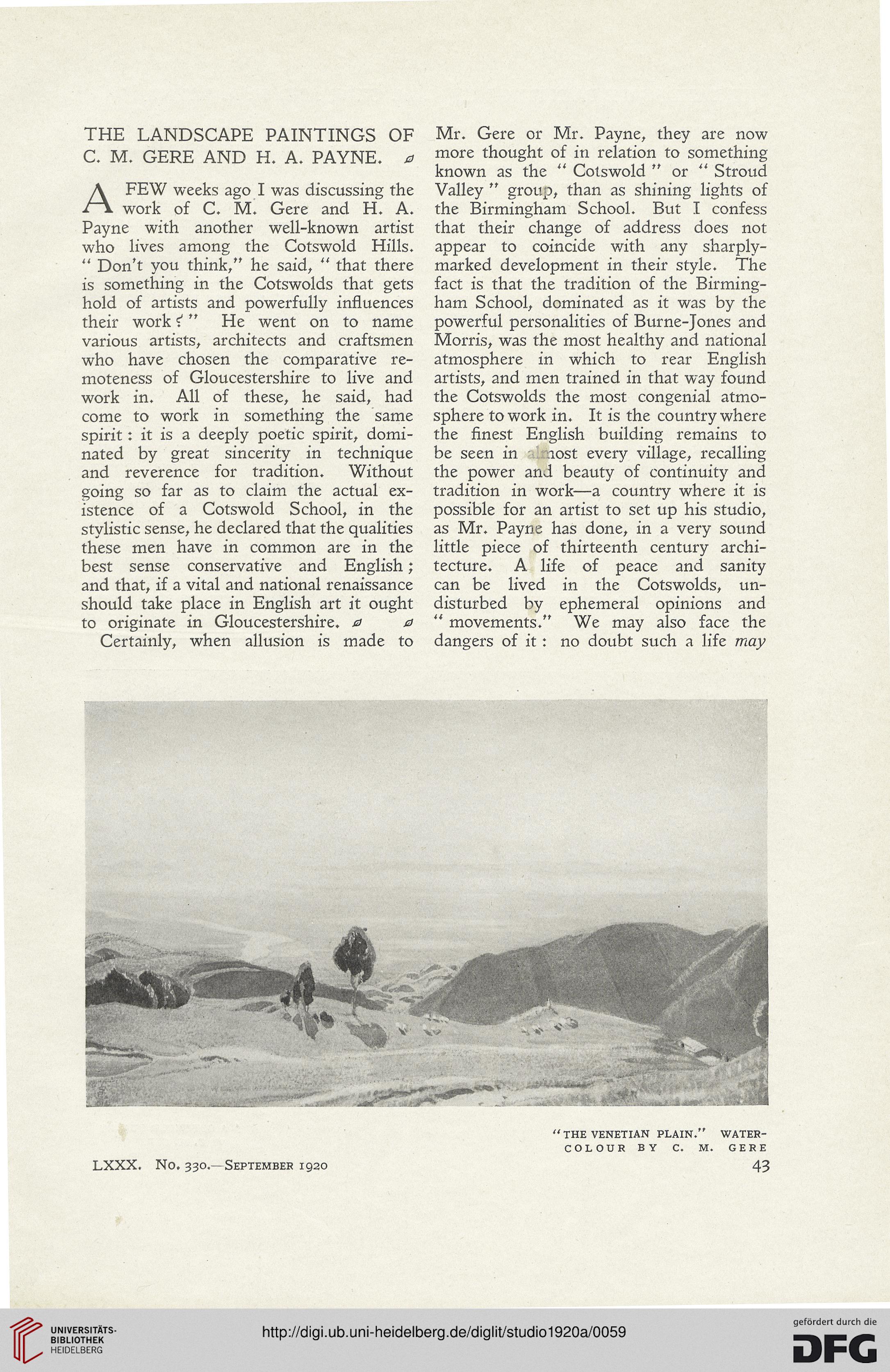THE LANDSCAPE PAINTINGS OF
C. M. GERE AND H. A. PAYNE, a
AFEW weeks ago I was discussing the
work of C. M. Gere and H. A.
Payne with another well-known artist
who lives among the Cotswold Hills.
" Don't you think," he said, " that there
is something in the Cotswolds that gets
hold of artists and powerfully influences
their work i" He went on to name
various artists, architects and craftsmen
who have chosen the comparative re-
moteness of Gloucestershire to live and
work in. All of these, he said, had
come to work in something the same
spirit: it is a deeply poetic spirit, domi-
nated by great sincerity in technique
and reverence for tradition. Without
going so far as to claim the actual ex-
istence of a Cotswold School, in the
stylistic sense, he declared that the qualities
these men have in common are in the
best sense conservative and English;
and that, if a vital and national renaissance
should take place in English art it ought
to originate in Gloucestershire, a a
Certainly, when allusion is made to
Mr. Gere or Mr. Payne, they are now
more thought of in relation to something
known as the " Cotswold " or " Stroud
Valley " group, than as shining lights of
the Birmingham School. But I confess
that their change of address does not
appear to coincide with any sharply-
marked development in their style. The
fact is that the tradition of the Birming-
ham School, dominated as it was by the
powerful personalities of Burne-Jones and
Morris, was the most healthy and national
atmosphere in which to rear English
artists, and men trained in that way found
the Cotswolds the most congenial atmo-
sphere to work in. It is the country where
the finest English building remains to
be seen in most every village, recalling
the power and beauty of continuity and
tradition in work—a country where it is
possible for an artist to set up his studio,
as Mr. Payne has done, in a very sound
little piece of thirteenth century archi-
tecture. A life of peace and sanity
can be lived in the Cotswolds, un-
disturbed by ephemeral opinions and
" movements." We may also face the
dangers of it: no doubt such a life may
LXXX. No, 330.—September 1920
" the venetian plain." water-
colour by c. m. gere
43
C. M. GERE AND H. A. PAYNE, a
AFEW weeks ago I was discussing the
work of C. M. Gere and H. A.
Payne with another well-known artist
who lives among the Cotswold Hills.
" Don't you think," he said, " that there
is something in the Cotswolds that gets
hold of artists and powerfully influences
their work i" He went on to name
various artists, architects and craftsmen
who have chosen the comparative re-
moteness of Gloucestershire to live and
work in. All of these, he said, had
come to work in something the same
spirit: it is a deeply poetic spirit, domi-
nated by great sincerity in technique
and reverence for tradition. Without
going so far as to claim the actual ex-
istence of a Cotswold School, in the
stylistic sense, he declared that the qualities
these men have in common are in the
best sense conservative and English;
and that, if a vital and national renaissance
should take place in English art it ought
to originate in Gloucestershire, a a
Certainly, when allusion is made to
Mr. Gere or Mr. Payne, they are now
more thought of in relation to something
known as the " Cotswold " or " Stroud
Valley " group, than as shining lights of
the Birmingham School. But I confess
that their change of address does not
appear to coincide with any sharply-
marked development in their style. The
fact is that the tradition of the Birming-
ham School, dominated as it was by the
powerful personalities of Burne-Jones and
Morris, was the most healthy and national
atmosphere in which to rear English
artists, and men trained in that way found
the Cotswolds the most congenial atmo-
sphere to work in. It is the country where
the finest English building remains to
be seen in most every village, recalling
the power and beauty of continuity and
tradition in work—a country where it is
possible for an artist to set up his studio,
as Mr. Payne has done, in a very sound
little piece of thirteenth century archi-
tecture. A life of peace and sanity
can be lived in the Cotswolds, un-
disturbed by ephemeral opinions and
" movements." We may also face the
dangers of it: no doubt such a life may
LXXX. No, 330.—September 1920
" the venetian plain." water-
colour by c. m. gere
43




